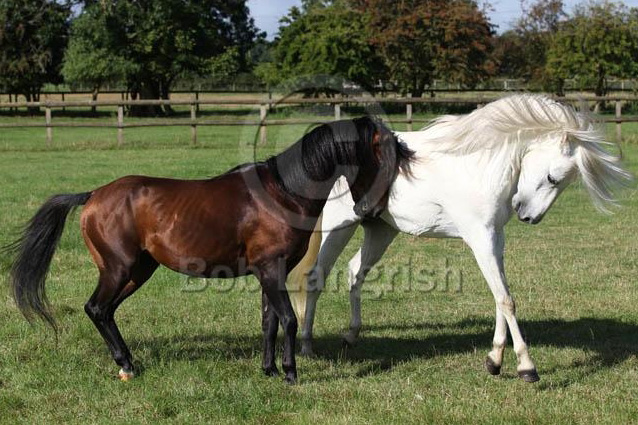Total hemoglobin and absolute level of hemoglobin A, however, showed significant differences between age groups (p<0.05). Correlations between measured parameters were also determined.
M. Mohri, H. Reihani and A. BadieeDepartment of Clinical Sciences, School of Veterinary Medicine, Ferdowsi University of Mashhad, Mashhad, Iran
Abstract
In order to study the haemoglobin types of the Caspian miniature horse, blood samples were collectedfrom 35 such horses, and haemoglobin electrophoresiswas carried out on lysates. Two types of haemoglobin, Aand B, were fractionated, and the levels of these typeswere determined for sex and for various age groups. Nosigni®cant differences were seen between the sexes forthe measured parameters. Total hemoglobin and absolutelevel of hemoglobin A, however, showed signi®cantdifferences between age groups (p<0.05). Correlationsbetween measured parameters were also determined.
Keywords: Caspian miniature horse; Electrophoresis;Haemoglobin type
Introduction
Perhaps the most exciting equine discovery of the 20th century was that the Caspian is not a pony, but an ancient breed of miniature horse, previously believed to have been extinct for over a thousand years. This tiny horse was probably one direct ancestor of the oriental breeds,and subsequently of all light horse breeds . These animals are extremely rare and were pulled back from the brink of extinction in 1965 by Louise Firouze, an American living in Iran (Hendricks 1995).
The Caspian miniature horse is a native of the area around the Elborz Mountains and Caspian Sea in Iran.The current theory is that the Caspian is the ancient miniature horse of the Mesopotamia which, after being used by the Mesopotamians in the third millenium BC until the seventh century AD, was believed to havebecome extinct (Edwards 1985).
Establishing continuity for a breed for more than 3000 years will be difficult, but failure to take an exhaustive look into the past of this unique little horse may result in the loss of the vestige of the wild horse of the Middle East. The greatest importance of the Caspian lies in the fact that if continuity can be proven, the breed is likely the ancestor of all modern breeds of hot-blooded horses(Edwards 1992; Hendricks 1995; Draper 1996).
In human medicine haemoglobin electrophoresis is the main method for the detection of haemoglobin variants,and may also be of importance in the differential diagnosis of various haemoglobinopathies (Chanarin 1989). Both qualitative and quantitative abnormalities have been reported in humans but not in animals (Jain1993). Electrophoretic markers (such as haemoglobin) are used extensively in horses because red blood cell antigens fail to provide the same degree of discrimination among individuals in this species (McClure and Parish 1996). Thus, the present study was performed for the detection of haemoglobin phenotypes of Caspian miniature horses and their levels for sex and for various age groups. To our knowledge this study is the first report of Caspian haemoglobin phenotypes.
Materials and Methods
A total of 35 Caspian miniature horses (15 female and 20 male) from a private stud belonging to Miss Louise Firouz were considered for this study. These horses were divided into three groups based on age: 1±3 years,4±6 years and 7 or more years.
Sampling was conducted from the jugular vein using disposable syringes and blood was added to EDTA-containing tubes and transferred to the laboratory on ice as soon as possible. The amounts of total haemoglobin (tHb) and haematocrit (PCV) were determined by cyanmethaemoglobin and microhaematocrit methods ,respectively, after which lysates were prepared byadding distilled water and chloroform to the samples,followed by shaking and centrifugation. Electrophoresiswas performed on cellulose acetate strips (350 V, 45 min) and after staining with Ponceau S, destaining ,clearing and drying, the levels of haemoglobin typeswere determined by densitometery.
The mean +standard deviation of tHb, PCV and types of haemoglobin were determined for sex and age groups. Independent t-test and ANOVA with multiple range Duncan test were used for statistical analysis;p<0.05 was considered to be significant. Correlation between measured parameters was detected by Pearson’s method.
Results
After electrophoresis on cellulose acetate, two types of haemoglobin were fractionated: fast, with high levels,and slow, with lower levels. These were named A and B,respectively. The rate of migration of the haemoglobintypes was identical for the Caspian miniature and thoroughbred horse, but migration was higher than haemoglobin of other domestic animals (cattle, sheepand dog). Regarding the above results, the haemoglobin phenotype of the Caspian is AB, the mean ratio of A: B being 1.75 +0.61.No significant differences were seen for tHb, PCV,percentage of HbA and HbB, absolute levels of HbA andHbB and A: B ratio between the sexes. Total haemoglobin and the absolute level of haemoglobin Ashowed significant differences between age groups, withhorses aged 7 years or more having higher tHb (p<0.05),and horses in age group 1±3 years having a lower amount of HbA (p<0.05).
The results are shown in Table 1. Correlation between the measured parameters is presented in Table 2.
Discussion
Information about the haematology and serum biochem-istry of Caspian miniature horses is limited, especiallyfor haemoglobin phenotypes.In this study, the levels of PCV and tHb for Caspian horese were 32.6% and 9.22 g/dl, respectively, the levels of tHb being lower than previously reported (Rezakhani 1978; Atyabi et al. 1999). Total haemoglobin and HbA levels showed significant differences between age groups (p<0.05), with advancing age resulting in increased tHb and HbA. The correlation coefficient also confirmed these results. This increase may be related to the effects of sex hormones. Atyabi et al.

